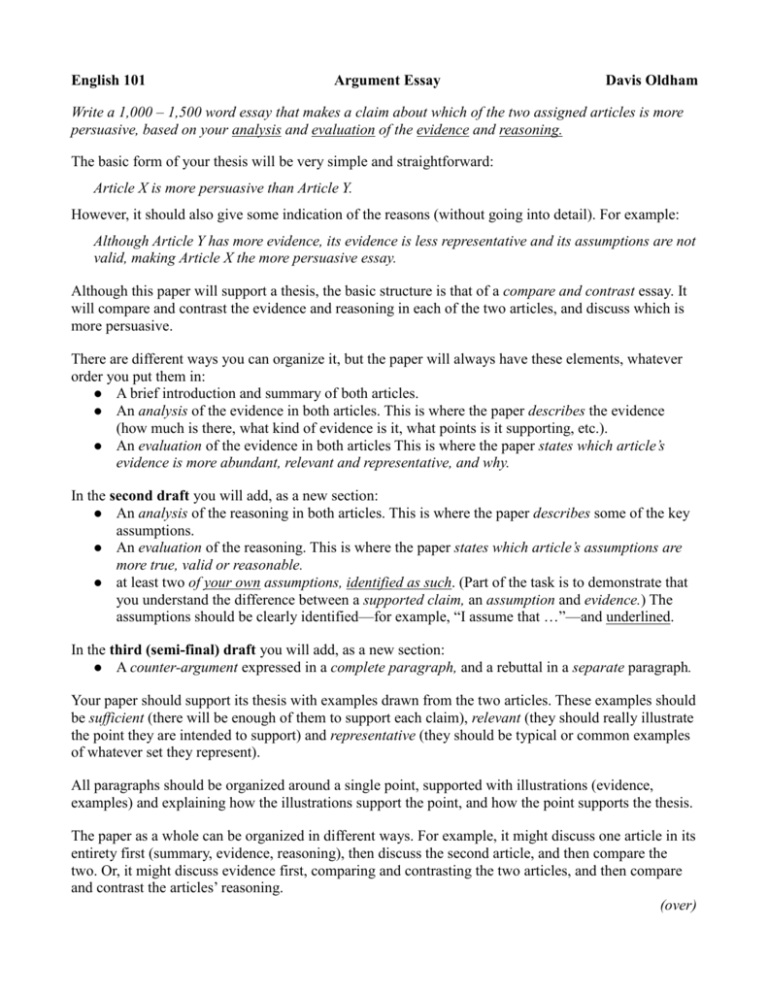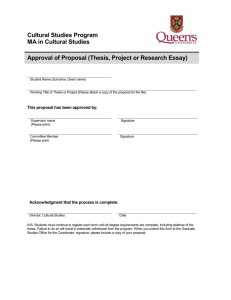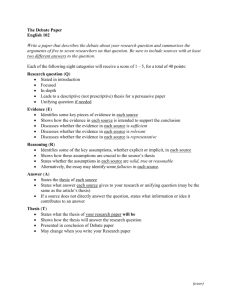English 101 Argument Essay Davis Oldham Write a 1,000 – 1,500
advertisement

English 101 Argument Essay Davis Oldham Write a 1,000 – 1,500 word essay that makes a claim about which of the two assigned articles is more persuasive, based on your analysis and evaluation of the evidence and reasoning. The basic form of your thesis will be very simple and straightforward: Article X is more persuasive than Article Y. However, it should also give some indication of the reasons (without going into detail). For example: Although Article Y has more evidence, its evidence is less representative and its assumptions are not valid, making Article X the more persuasive essay. Although this paper will support a thesis, the basic structure is that of a compare and contrast essay. It will compare and contrast the evidence and reasoning in each of the two articles, and discuss which is more persuasive. There are different ways you can organize it, but the paper will always have these elements, whatever order you put them in: A brief introduction and summary of both articles. An analysis of the evidence in both articles. This is where the paper describes the evidence (how much is there, what kind of evidence is it, what points is it supporting, etc.). An evaluation of the evidence in both articles This is where the paper states which article’s evidence is more abundant, relevant and representative, and why. In the second draft you will add, as a new section: An analysis of the reasoning in both articles. This is where the paper describes some of the key assumptions. An evaluation of the reasoning. This is where the paper states which article’s assumptions are more true, valid or reasonable. at least two of your own assumptions, identified as such. (Part of the task is to demonstrate that you understand the difference between a supported claim, an assumption and evidence.) The assumptions should be clearly identified—for example, “I assume that …”—and underlined. In the third (semi-final) draft you will add, as a new section: A counter-argument expressed in a complete paragraph, and a rebuttal in a separate paragraph. Your paper should support its thesis with examples drawn from the two articles. These examples should be sufficient (there will be enough of them to support each claim), relevant (they should really illustrate the point they are intended to support) and representative (they should be typical or common examples of whatever set they represent). All paragraphs should be organized around a single point, supported with illustrations (evidence, examples) and explaining how the illustrations support the point, and how the point supports the thesis. The paper as a whole can be organized in different ways. For example, it might discuss one article in its entirety first (summary, evidence, reasoning), then discuss the second article, and then compare the two. Or, it might discuss evidence first, comparing and contrasting the two articles, and then compare and contrast the articles’ reasoning. (over) However you choose to approach it, the essay must meet these requirements: The paper should introduce and briefly summarize each article. The thesis should be expressed as a complete statement early in the paper The thesis should be understandable, coherent and arguable. The paper should analyze the evidence in each article. The paper should evaluate the evidence in each article. The second draft should analyze the reasoning in each article, The second draft should evaluate the reasoning in each article, The second draft should include at least two of your own assumptions, identified as such, on which your argument rests. (Part of the task is to demonstrate that you understand the difference between a supported claim, an assumption and evidence.) Your assumptions should be clearly identified—for example, “I assume that …”—and underlined. The third (semi-final) draft should have a counter-argument and a rebuttal. All parts of the essay should help to support the thesis. The paper should proceed in a logical fashion through a series of steps to prove the thesis. The thesis should be supported with evidence that is sufficient, relevant and representative. The paper should explain how or why the evidence supports the thesis. Grading Each of the tasks listed above will be scored from 0-4. The grade will be the average of those scores. An “A” paper (3.5 – 4.0) will perform most of these tasks superbly, without flaw. A “B” paper (2.5 – 3.4) will exhibit minor flaws in most areas—for example, a somewhat vague or obvious thesis, evidence that is somewhat insufficient, imperfect explanation of how the evidence supports the conclusion; unlikely or unconvincing counter-argument; less relevant assumptions. A “C” paper (1.5 – 2.4) will exhibit noticeable flaws in most areas—for example, a confused or unfocused thesis; evidence that is not sufficient, relevant or representative; difficulty showing how the evidence supports the thesis; under-developed counter-argument or rebuttal; assumptions mis-identified or poorly explained. A “D” paper (0.8 – 1.4) will exhibit significant flaws in most areas—for example, a thesis split between two different ideas; seriously insufficient, irrelevant or unrepresentative evidence; reasoning that largely fails to explain how the evidence leads to the conclusion; 1-sentence or missing counterargument; failure to identify assumptions. An “F” paper (0.7 or below) will be one that simply does not respond to the assignment. Format Formatting requirements are the same as for the other two papers (typed, double-spaced, name and page number on every page, number of words on page 1, with a title above the first paragraph, etc.).






